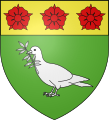Olive tree (heraldry)
In heraldry , the olive tree and the olive branch are heraldic figures that are often used. These figures came into the coats of arms late and the Renaissance can be seen as the beginning. Another name is olive tree and olive branch . They have been considered symbols of peace since ancient times and in the Christian world.
The tree is represented in the coat of arms with a particularly strong trunk and a lush crown is not missing. Roots are strongly suggested, but cannot be described as "pulled out" as is the case with other trees. If the stem does not have a special tincture , then everything is colored in green, gold or silver.
The olive branch is also shown in the coat of arms primarily in green, occasionally with conspicuous fruits. Heraldic metals , i.e. gold and silver, are only preferred when a dove holds the olive branch in its beak . The unity of heraldic bird and branch is considered a special religious symbol. In the coat of arms of Pope Pius XII. holds a pigeon sitting on a mountain of three a branch.
The olive branch is also often taken as a gem . In combination with other branches, such as laurel or oak branches , it is placed around one side of the coat of arms.
Only the olive fruit in the coat of arms is rare. It can be found, for example, in the family coat of arms of Jean-Charles-Léonard Simonde de Sismondi , who came from Geneva , and in the coat of arms of Bretonneau de Moydier, which has the same coat of arms, the French Simond de Moydier and the French Simond de Moydier or Simonde de Sismondi from Geneva, lead.
Examples
literature
- Walter Leonhard : The great book of heraldic art. Development, elements, motifs, design. Bechtermünz, Augsburg 2001, ISBN 3-8289-0768-7 .







